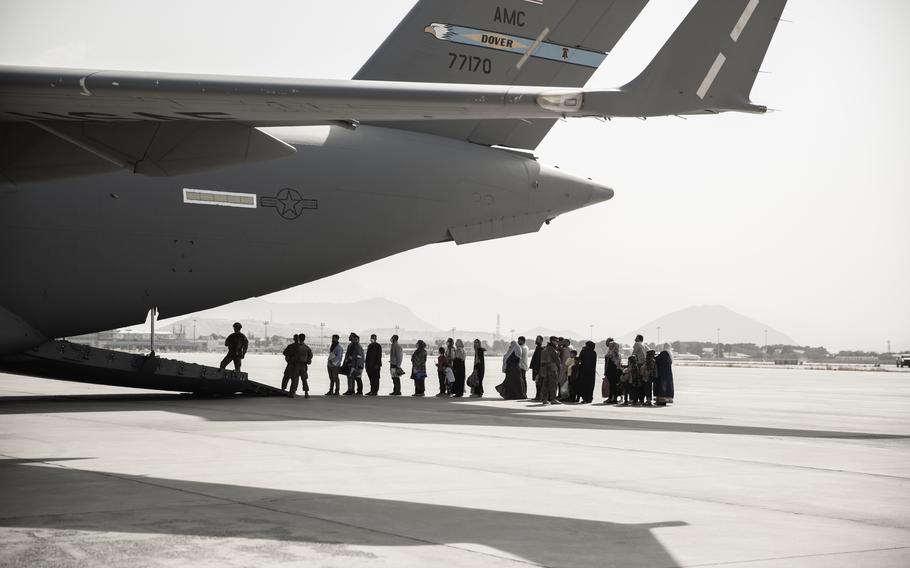
Evacuees wait to board a Boeing C-17 Globemaster III during an evacuation at Hamid Karzai International Airport, Kabul, Afghanistan, Aug. 30, 2021. (Victor Mancillal/U.S. Marine Corps)
The assignment was to set up an airline from scratch at an airport surrounded by war with flights to dozens of destinations.
Finding those destinations for the Americans and Afghans evacuated from Afghanistan last year was an urgent, and ever-changing, diplomatic mission.
Making that work was the task of 30 operations planners from a small Norfolk-based military team: the Joint Enabling Capabilities Command, working with senior State Department leaders.
“What we were hearing was a chaotic situation on the ground,” said Rear Adm. Paul C. Spedero Jr., the JECC’s commanding officer.
“We had to evacuate 125,000 who were in a landlocked country, hours away from any allies or partners, and we did it in two weeks,” he said, talking for the first time about the JECC’s Afghan mission.
For Spedero and his planners, it meant scheduling and then re-scheduling aircraft as the numbers of people arriving at Kabul airport ebbed and flowed, all in coordination with the State Department, Homeland Security and Health and Human Services agents.
All the while, too, the JECC team had to make sure that airfields at the other end of those flights weren’t overwhelmed.
Sometimes, word came back through the State Department that one of the countries at the end of the rescue flights couldn’t take more people.
Rear Adm. Paul C. Spedero Jr. is the commanding officer of the the Joint Enabling Capabilities Command. (U.S. Navy)
That meant scrambling — for the State Department leaders to figure out which nations would accept them and for the JECC team to work out logistics, including the painful equation of how many desperate people would have to stay how long in Kabul for every extra hour or two of flight time.
The situation at the gate on any day could mean still another change to the plan.
They’d get a sense of what the day would bring when people inside the Kabul airport fence made cellphone contact with others trying to make their way through chaotic streets. The people inside the fence, including members of another JECC team, would relay updates to Washington.
At times, security at the gates risked being overwhelmed; on one dreadful day, terrorist bombs cost 13 American troops and dozens of civilians their lives.
There were other challenges demanding plan revisions, too — including unaccompanied children.
When enough of them showed up or enough individuals in wheelchairs or needing medical care made it through the gate at Kabul, Spedero’s team would have still more juggling to do.
And they had to watch what was happening at the destinations.
“If we had too many planes at one place, taxiing and taking off could slow down,” Spedero said.
On top of all that, his team also had to figure out a plan to move people on from those first destinations, all in the Gulf.
Sometimes, that was a direct connection to either Dulles or the Philadelphia airport, with connections on from there. Sometimes, it meant a connection through Europe. The JECC team handled arrangements with U.S.-flag airlines, their State Department counterparts handling contracting with foreign airlines.
Hastening to take on operations planning, set up communications and handling public affairs for a new joint task force is the basic mission for JECC, and the Pentagon turned to the command immediately upon the decision to speed up the evacuation.
They were in Kabul right after that.
But the complications of moving people from Kabul to other foreign points meant a new challenge for the military — and so Spedero and more than 30 teammates took their existing expertise with operations planning for a new-formed task force to a new venue: the State Department.
“I think we learned a lot,” Spedero said.
But it was just one of 72 alert missions over the past year, that ranged from facilitating COVID-19 vaccination programs to disaster relief after Hurricane Ida to speeding troops and equipment to NATO’s eastern flank as Russia threatened and then invaded Ukraine.
“There is a reason you are an Immediate Response Force,” Air Force Gen. Jacqueline Van Ovost told the JECC as she marked the end of Spedero’s tour.
“No one else can operate at the speed, scale, or precision necessary to meet combatant commander needs.”
©2022 Daily Press.
Visit dailypress.com.
Distributed by Tribune Content Agency, LLC.